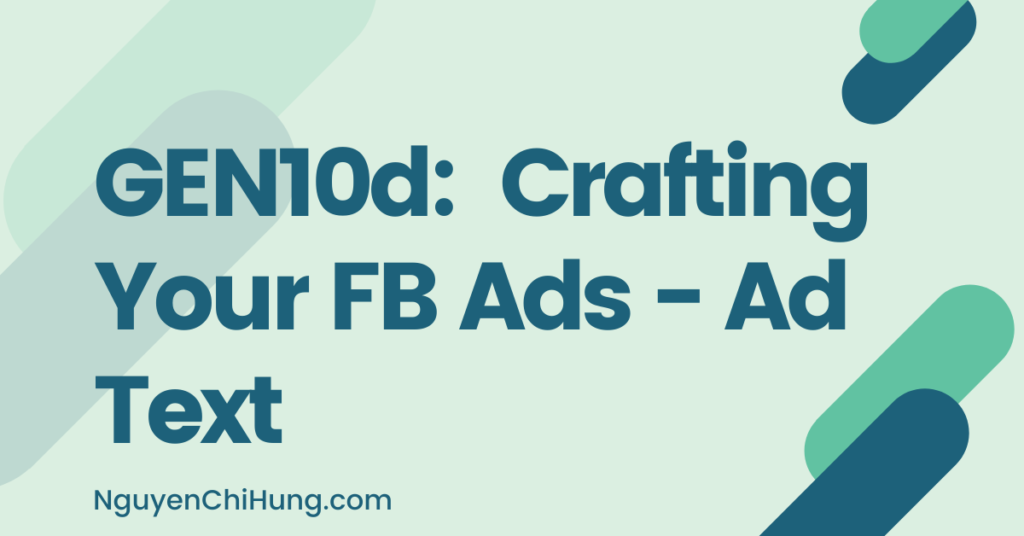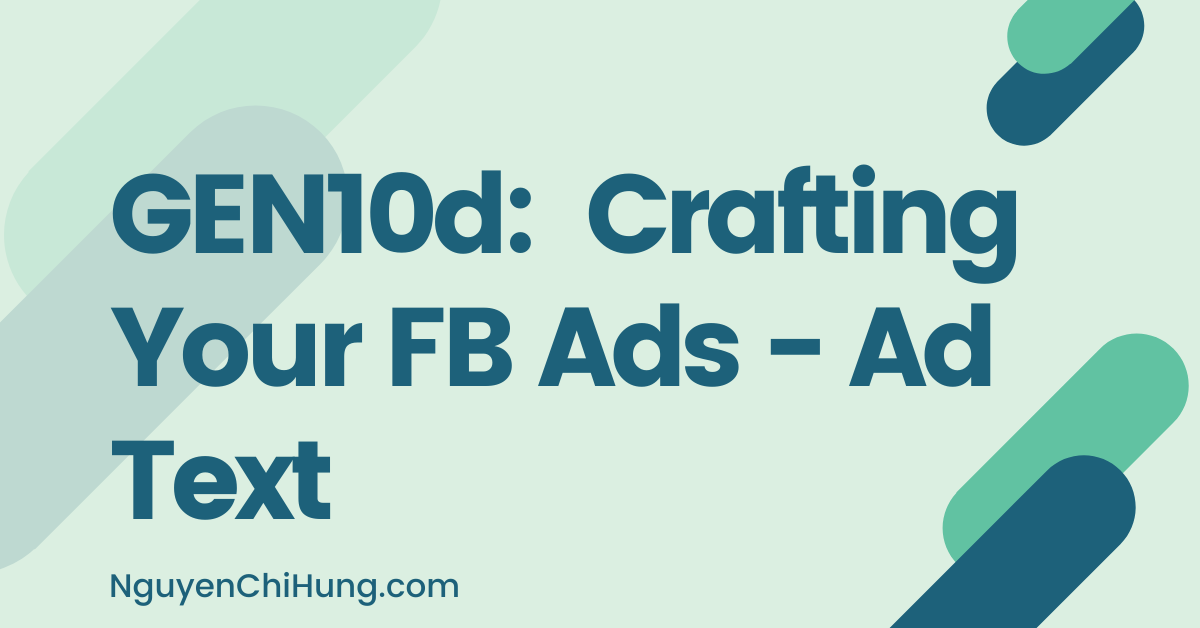GEN10d: Crafting Your FB Ads – Ad Text

In the last few posts, we talk about the video/image portion of the FB ad.
In this post I want to quickly talk about the ad text portion before we launch the campaign.
***************
Some General Advice
1)I personally find that when it comes to testing ads, we need to get 4 main things right – in this order:
-Audience targeting (audience has to need/want what you’re selling)
-Advertising angle (one or more angles that will strike the right chord with each audience)
-Video/image in the ad (which is usually the first thing users will notice, and what will make them stop to check out the ad text and/or click through)
-Ad text
Thus I would suggest not to do too much testing (if at all) of the ad text in the beginning, while you’re still testing the first three pieces of the puzzle.
Therefore, I would recommend that you keep the ad text the same for each adset (of 3 ads per angle+audience combination) in the beginning.
Once you run the campaign and start seeing some promising audience+angle combinations, that would be the time to possibly start testing ad text (I would still focus on testing videos/images first to find winners, before testing ad text).
2)To get inspiration on how to write your ad text, consult your research doc. You should already know the pleasure and pain points of your potential customers, the jargon they use etc.
And of course, spy tools can help.
I also like to browse user reviews of the type of product/service I’m promoting (the exact product or competitor products) and reword those.
Entire books have been written on copywriting, and it’s a topic that is outside the scope of this beginner’s tutorial. But we have an entire subforum dedicated to this topic.
And: Even if you read nothing else, please at least read Cashvertising by Drew Whitman. It’s recognized by many as the bible of online marketers.
3)I have two free online tools to recommend to you, that have been instrumental in making my ads look catchy:
a)Yay Text – Lets you style your ad text. I mostly just use bold, and sometimes italics, but you can check out the other options in the sidebar.
b)FBEmojis – A massive list of FB emojis you can copy and paste into your ads. And I love that they have a search function!
Just don’t go overboard with styling or emojis or your ad could turn out looking ridiculous. Don’t use these like you would sugar – use sparingly like you would with salt.
The 3 Ad Text Components
There are 3 ad text components: Primary Text, Headline, and Description.
In this post, we’ve looked at where these components are located on a sample ad. You can also go back to the Creative Hub to add these text components to the videos/images you’ve uploaded from before, to see what the entire ad would look like.
Below are some tips on each component.
Headline:
According to AdEspresso, based on their analysis of 750k ads over several years, the ideal length of headlines is 5 words.
This is in line with my personal experience – I’ve found that when it comes to ad text, less is often more.
The character limit for headlines is 25 characters. That’s not a hard limit, but anything longer than 25 characters may get cut off when displayed in some placements. So if you want to test headlines that are longer than 25 characters, at least put the crucial information in the first 25 characters.
Primary Text:
Also according to AdEspresso’s analysis mentioned above, the ideal length for the Primary Text is around 20 words.
As for the headline, for primary text it’s also often the case that less is more. Sure, we’ve all seen ads with really long primary text, and longer text CAN work well. But I would suggest that when doing initial testing for an offer, that you at go with shorter text. Once you get the audience, angle, and video/image right, you can always test longer text.
(The exception here is that for some reason, you’re not using a landing page, or if you’re using a weak landing page, such that you’re having to use the ad for the heavy-lifting in pre-selling/pre-qualifying users.)
The “officially stated” character limit for primary text is 125 characters. Again, it’s not a hard limit (remembering the really long ads we’ve seen), but only the first 125 characters are guaranteed to be displayed. For some placements, the audience can click on the “Continue Reading” to expand the text:

So again, even if you want to test longer copy, make sure to put the most important stuff in the first 125 characters.
Also: If you’re going to test slightly-longer copy, bullets points can work extremely well. Try using an emoji as bullets. Put a series of 3 benefits for example.

Lastly: Although the URL already has its own location in the ad, I’ve found that by including one or more links within the Primary Text can improve results. I’ve used link shorteners like bit.ly (you need to register for a free account now – didn’t used to be required), and have registered relevant domains and set for it to redirect to the offer link. Both approaches seem to work well.
Description:
The official character limit for descriptions is 30 characters. Again – not a hard limit, but anything longer may not show.
I like to use the description to highlight a benefit, but of course feel free to do your own testing.
Dynamic Ads
When we set up the campaign later, you’ll be offered the option of choosing whether you want to create dynamic ads or not.

If you toggle this to “on”, then you’ll have the option to add multiple versions of primary text, headlines, descriptions, and call to actions, in the same ad.
What would happen then is that FB would then serve different combinations of all these variations to the audience. And FB will assign more and more traffic to the variations that it feels are performing the best (e.g. highest conversion rate, lowest CPC, highest CTR etc.)
Pros: Ad fatigue would seep in more slowly because of all the different ad versions, so you’d be able to run ads for longer without having to replace them as often. Ads can potentially convert better as FB will automatically show the best combinations to the audience.
Cons: Can’t accumulate post engagement (comments, likes, shares) – each combination would be a different ad with its own engagement, so instead of having one ad with all the engagement, you’d have many ads each with a fraction of the engagement (and engagement can be a powerful conversion tool, as people tend to want to see positive social proof before buying what you have to sell). Also: Can’t drill down into multiple levels, e.g. you can’t see which image+headline combination is the best – you’d only know which image is the best and which headline is the best, separately. You can’t pause ad versions either. Another things is that with more versions, the ad would require a larger budget to collect enough data on all versions to see which ones are best.
I don’t have a definite suggestion as to whether to use Dynamic Creatives or not – sometimes they work better than individual ads and other times not. You’re welcome to test both (in fact, you should).
However, if this is your first campaign, I’d suggest to keep things simple by leaving “Dynamic Creative” OFF. But I want to briefly go over this as something you can test later on.
Organization and Naming Convention
I have a google sheet for every offer where I’d construct and save all my ad text.
It’s really simple – has one tab for Primary Text, another tab for Headlines, and a third for Descriptions.
My naming convention is simple as well: #1 , 2, 3, 4…
Here’s an example of these tabs:



The formula for calculating the character length: =LEN()
To start a new line within a cell: CTRL+ENTER
Simple.
Other Ad Text Related Tips
-People respond well to numbers. Especially: Try to use numbers at the beginning of your headline.
–Be VERY clear, concise, direct, to-the-point – you get the idea! People read all kinds of stuff on the internet every day, and the average human attention span is getting shorter all the time.
I know I’m very long-winded when it comes to writing guides, but that’s only because I want to help newbie members. I definitely don’t take the same approach when it comes to writing ad text. NOBODY has the patience to figure out riddles or read long copy these days. Keep rewriting your ad text with the aim of making it more direct and concise, until you can’t anymore, and then try harder still. This is probably the most important advice I have regarding ad text.
***************
Now that we have videos, images, and ad text all ready to go, let’s FINALLY go set up that campaign!
Amy
